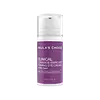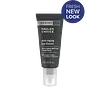What's inside
What's inside
 Key Ingredients
Key Ingredients

 Benefits
Benefits

 Concerns
Concerns

 Ingredients Side-by-side
Ingredients Side-by-side

Water
Skin ConditioningNeopentyl Glycol Diheptanoate
EmollientCetyl Alcohol
EmollientButylene Glycol
HumectantGlycerin
HumectantGlyceryl Stearate
EmollientPEG-100 Stearate
Ammonium Acryloyldimethyltaurate/Vp Copolymer
Ascorbyl Glucoside
AntioxidantPotassium Cetyl Phosphate
EmulsifyingSodium Ascorbyl Phosphate
AntioxidantBis-Diglyceryl Polyacyladipate-2
EmollientPolyglyceryl-10 Dioleate
EmulsifyingTetrahexyldecyl Ascorbate
AntioxidantCeramide Ns
Skin ConditioningCeramide EOP
Skin ConditioningCeramide AP
Skin ConditioningCeramide Eos
Skin ConditioningCeramide NP
Skin ConditioningPalmitoyl Tripeptide-5
Skin ConditioningAcetyl Tetrapeptide-5
HumectantCaprooyl Phytosphingosine
Skin ConditioningCaprooyl Sphingosine
Skin ConditioningCholesterol
EmollientSqualane
EmollientRetinol
Skin ConditioningVitis Vinifera Seed Extract
AntimicrobialGlycyrrhiza Glabra Root Extract
BleachingPunica Granatum Fruit Extract
AntioxidantDunaliella Salina Extract
Skin ConditioningPongamia Glabra Seed Oil
Skin ConditioningTocopheryl Acetate
AntioxidantAllantoin
Skin ConditioningBisabolol
MaskingCarnosine
Skin ConditioningPanthenol
Skin ConditioningSodium PCA
HumectantPullulan
Glyceryl Ascorbate
AntioxidantBehenic Acid
CleansingDimethicone
EmollientSodium Citrate
BufferingSodium Polyacrylate
AbsorbentCaprylyl Glycol
EmollientEthylhexyl Stearate
EmollientCeteareth-25
CleansingSodium Hydroxide
BufferingTrideceth-6
EmulsifyingPropyl Gallate
AntioxidantPolysorbate 20
EmulsifyingDisodium EDTA
Mica
Cosmetic ColorantPhenoxyethanol
PreservativeChlorphenesin
AntimicrobialSodium Benzoate
MaskingWater, Neopentyl Glycol Diheptanoate, Cetyl Alcohol, Butylene Glycol, Glycerin, Glyceryl Stearate, PEG-100 Stearate, Ammonium Acryloyldimethyltaurate/Vp Copolymer, Ascorbyl Glucoside, Potassium Cetyl Phosphate, Sodium Ascorbyl Phosphate, Bis-Diglyceryl Polyacyladipate-2, Polyglyceryl-10 Dioleate, Tetrahexyldecyl Ascorbate, Ceramide Ns, Ceramide EOP, Ceramide AP, Ceramide Eos, Ceramide NP, Palmitoyl Tripeptide-5, Acetyl Tetrapeptide-5, Caprooyl Phytosphingosine, Caprooyl Sphingosine, Cholesterol, Squalane, Retinol, Vitis Vinifera Seed Extract, Glycyrrhiza Glabra Root Extract, Punica Granatum Fruit Extract, Dunaliella Salina Extract, Pongamia Glabra Seed Oil, Tocopheryl Acetate, Allantoin, Bisabolol, Carnosine, Panthenol, Sodium PCA, Pullulan, Glyceryl Ascorbate, Behenic Acid, Dimethicone, Sodium Citrate, Sodium Polyacrylate, Caprylyl Glycol, Ethylhexyl Stearate, Ceteareth-25, Sodium Hydroxide, Trideceth-6, Propyl Gallate, Polysorbate 20, Disodium EDTA, Mica, Phenoxyethanol, Chlorphenesin, Sodium Benzoate
Water
Skin ConditioningDimethicone
EmollientSodium PCA
HumectantHydrogenated Polyisobutene
EmollientAscorbyl Glucoside
AntioxidantSodium Polyacrylate
AbsorbentHydrogenated Lecithin
EmulsifyingGlucosyl Hesperidin
HumectantCopper Gluconate
Skin ConditioningTroxerutin
Skin ConditioningDisodium Rutinyl Disulfate
AntioxidantResveratrol
AntioxidantPalmitoyl Tripeptide-38
Skin ConditioningCaprooyl Tetrapeptide-3
Skin ProtectingGlycyrrhiza Glabra Root Extract
BleachingPhytic Acid
Beta-Glucan
Skin ConditioningAcetyl Glucosamine
Skin ConditioningTocopherol
AntioxidantAllantoin
Skin ConditioningAdenosine
Skin ConditioningDextran
Caprylic/Capric Triglyceride
MaskingSea Whip Extract
Skin ConditioningArctostaphylos Uva Ursi Leaf Extract
Skin ConditioningSalix Alba Bark Extract
AstringentPolyacrylate Crosspolymer-6
Emulsion StabilisingHydroxypropyl Cyclodextrin
MaskingXanthan Gum
EmulsifyingCetearyl Alcohol
EmollientMaltodextrin
AbsorbentBenzyl Alcohol
PerfumingPhenoxyethanol
PreservativeWater, Dimethicone, Sodium PCA, Hydrogenated Polyisobutene, Ascorbyl Glucoside, Sodium Polyacrylate, Hydrogenated Lecithin, Glucosyl Hesperidin, Copper Gluconate, Troxerutin, Disodium Rutinyl Disulfate, Resveratrol, Palmitoyl Tripeptide-38, Caprooyl Tetrapeptide-3, Glycyrrhiza Glabra Root Extract, Phytic Acid, Beta-Glucan, Acetyl Glucosamine, Tocopherol, Allantoin, Adenosine, Dextran, Caprylic/Capric Triglyceride, Sea Whip Extract, Arctostaphylos Uva Ursi Leaf Extract, Salix Alba Bark Extract, Polyacrylate Crosspolymer-6, Hydroxypropyl Cyclodextrin, Xanthan Gum, Cetearyl Alcohol, Maltodextrin, Benzyl Alcohol, Phenoxyethanol
 Reviews
Reviews

Alternatives
Ingredients Explained
These ingredients are found in both products.
Ingredients higher up in an ingredient list are typically present in a larger amount.
Allantoin is a soothing ingredient known for its protective and moisturizingg properties. Because of this, it is often added to products with strong active ingredients.
Studies show higher concentrations of this ingredient can promote wound healing.
Though it can be derived from the comfrey plant, allantoin is produced synthetically for cosmetic products to ensure purity.
Learn more about AllantoinAscorbyl Glucoside is a stable form of Vitamin C. It is created by combining glucose from starch.
When applied to skin, Ascorbyl Glucoside turns into Ascorbic Acid.
Ascorbyl Glucoside is an antioxidant. Antioxidants help fight free-radicals, or molecules that may damage skin cells.
It can help to reduce redness, improve skin texture, reduce the effects of aging, reduce the visibility of dark spots, and brighten skin.
Read more about other types of Vitamin C:
Learn more about Ascorbyl GlucosideDimethicone is a type of synthetic silicone created from natural materials such as quartz.
What it does:
Dimethicone comes in different viscosities:
Depending on the viscosity, dimethicone has different properties.
Ingredients lists don't always show which type is used, so we recommend reaching out to the brand if you have questions about the viscosity.
This ingredient is unlikely to cause irritation because it does not get absorbed into skin. However, people with silicone allergies should be careful about using this ingredient.
Note: Dimethicone may contribute to pilling. This is because it is not oil or water soluble, so pilling may occur when layered with products. When mixed with heavy oils in a formula, the outcome is also quite greasy.
Learn more about DimethiconeGlycyrrhiza Glabra Root Extract is an extract of the roots of Licorice. It has been found to have several benefits such as skin hydrating, conditioning, and soothing.
One component, glabridin, has extra potent antioxidant and soothing properties. It has also been found to block pigmentation from UVB rays in guinea pigs.
Licorice Root also contains a flavonoid. Flavonoids are a natural substance from in plants. Flavonoids also have antioxidant properties.
Another component, glycyrrhizin, has been found to have anti-inflammatory and antimicrobial benefits. This may make licorice root extract effective at treating acne. However, more research is needed to support this.
Liquiritin is one of the flavone compounds found in licorice. It has been found to help lighten skin by preventing tyrosinase from reacting with tyrosine. When the two react, protein is converted to melanin. Melanin is the substance in your body that gives your features pigmentation.
Learn more about Glycyrrhiza Glabra Root ExtractPhenoxyethanol is a preservative that has germicide, antimicrobial, and aromatic properties. Studies show that phenoxyethanol can prevent microbial growth. By itself, it has a scent that is similar to that of a rose.
It's often used in formulations along with Caprylyl Glycol to preserve the shelf life of products.
Sodium PCA is the sodium salt of pyroglutamic acid. It is naturally occurring in our skin's natural moisturizing factors where it works to maintain hydration.
The PCA stands for pyrrolidone carboxylic acid, a natural amino acid derivative.
This ingredient has skin conditioning, anti-inflammatory, and humectant properties. Humectants help hydrate your skin by drawing moisture from the air. This helps keep your skin moisturized.
Learn more about Sodium PCASodium Polyacrylate is the sodium salt of polyacrylic acid. It is used as an absorber, emollient, and stabilizer.
This ingredient is a super-absorbent polymer - meaning it can absorb 100 to 1000 times its mass in water. As an emollient, Sodium Polyacrylate helps soften and soothe skin. Emollients work by creating a barrier to trap moisture in. This helps keep your skin hydrated.
Water. It's the most common cosmetic ingredient of all. You'll usually see it at the top of ingredient lists, meaning that it makes up the largest part of the product.
So why is it so popular? Water most often acts as a solvent - this means that it helps dissolve other ingredients into the formulation.
You'll also recognize water as that liquid we all need to stay alive. If you see this, drink a glass of water. Stay hydrated!
Learn more about Water